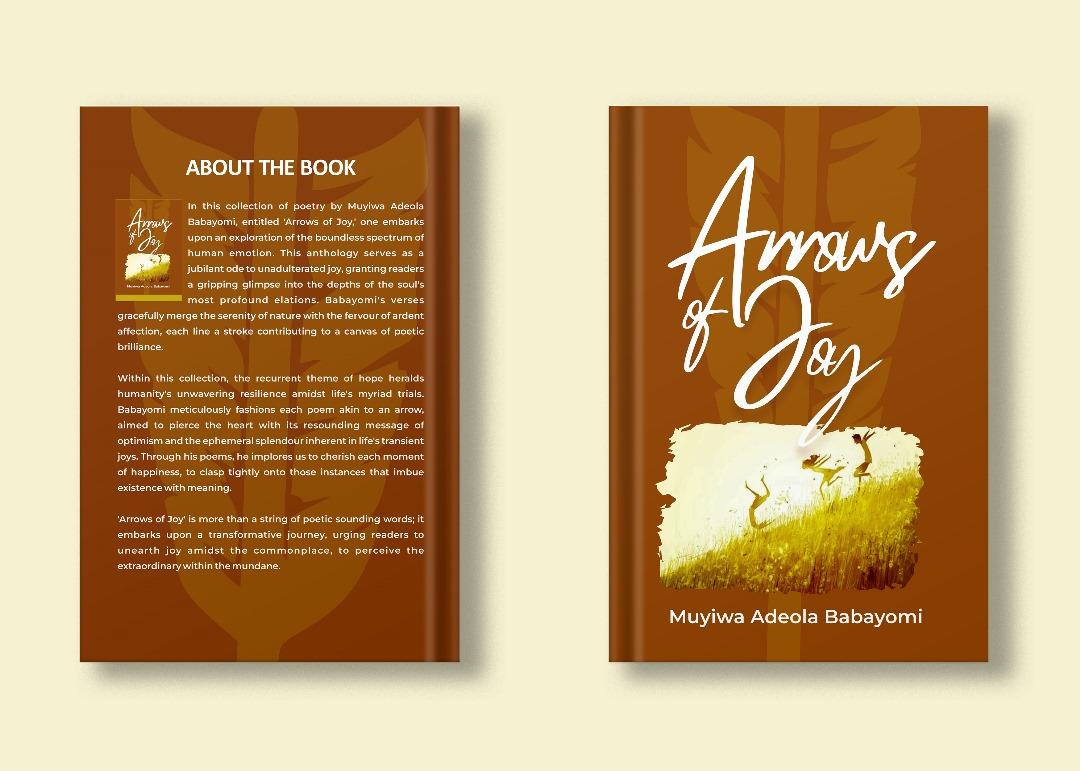
A display of book covers
Reviewer : Molara Woods.
Muyiwa Adeola Babayomi’s Arrows of Joy is a richly layered collection that seeks to capture the ways of life of Africans and their cultural heritage. This body of work takes the reader on a walk to deliberate Africa myths, their rich history, their ever-vibrant community. Babayomi’s arrow of Joy uses free verse, metaphor, and vivid imagery to explores themes of hope, cultural identity, wildlife tales, aquatic splendour and spiritual reflection.
Babayomi’s exploration of cultural themes was evident throughout the collection, particularly in “Home of the Rising Sun” and “In the Vast Expanse of the Savannah.” The former touches on historical trauma while reaffirming the pride in Africa’s legacy. Babayomi uses the ancient name Alkebulan to symbolize a sense of unity and shared heritage. This thematic thread continues in “Sunset,” which juxtaposes the melancholy of fading light with the hope that persists in its wake. “Home of the Rising Sun” cleverly uses a call-and-response structure to evoke a conversation with the continent itself, while “Sunset” employs imagery and metaphor to convey how memories of struggle can inspire perseverance.
The collection also includes spiritual reflections, particularly in poems like “Burning Bush,” “Lily Paths,” and “Streams of Joy.” In “Burning Bush,” Babayomi references Moses, using Biblical imagery to explore themes of destiny and transformation. “Lily Paths” and “Streams of Joy” blend spiritual and natural elements, reminding readers of the promise of faith.
Imagery and Language
Babayomi’s mastery of imagery is recurrent throughout the collection. In “Sunset,” he vividly describes “a towering sprawl of mountains” and “the clean pleasure of the evening breeze,”. In “Rain,” he reimagines a rainy day with “umbrellas twirling in a clumsy fit.” The sensory details make the landscapes come alive and invite readers into his poetic world. His use of metaphors like “Rays of light seeping through the cringing sore of the gaping empty windows” in “Sunset” adds layers of meaning that evoke strong emotional undertones.
The language also incorporates alliteration and consonance, with rhythmic lines like “In realms above, where endless light does gleam, / Zion raves in Heaven’s gracious palms.” This recurring musicality within “Arrows of Joy” enhances the overall reading experience. It lends, to the poems, a rhythm that feels natural and intuitive.
Structurally, Arrows of Joy follows a free-verse form, which allows Babayomi to explore various themes with fluidity. His shifts between direct address and narrative storytelling are smooth. This creates a cohesive collection that reads as a journey through a landscape of culture and spirituality. However, at times, the free-verse structure can lead to a lack of consistent pacing in certain poems, where some lines could benefit from more focused editing to sharpen their impact.
Babayomi’s collection is ambitious and thought-provoking, some areas could definitely be refined to enhance enjoyable readability. For instance, certain metaphors and images in poems like “Facework” and “Thunderclouds” are occasionally too esoteric and could make the message too hard to decipher without additional context. This opacity could alienate readers unfamiliar with the cultural references.
Additionally, the collection would benefit from a stronger narrative thread that ties the poems together more cohesively. By expanding on the narrative structures within each piece, Babayomi could create a greater sense of continuity throughout the collection, making it feel like a unified whole rather than a series of individual explorations.
Arrows of Joy is a compelling work that thoughtfully examines Africa’s cultural legacy. Babayomi’s use of layered metaphors, imagery and rhythmic language draws readers into a poetic world where ranges of emotions coexist. The collection offers a rich exploration of its themes. Babayomi demonstrates a clear poetic voice, making Arrows of Joy a collection worth reading, and one that leaves room for future improvement.








